San Francisco Museum of Modern Art (SFMOMA) has opened its newly expanded museum, designed by the architecture firm Snøhetta to celebrate the museum’s 75th anniversary. Included in the redesign are technological innovations—app-based audio tours, virtual maps, and curated online exhibitions—as well as architectural ones—namely, an exponential expansion aiming to integrate a new 10-story gallery with the original 1995 Mario Botta building.
Why is this renovation significant? Does this technology separate us from the art itself, while diminishing the need for physical museum spaces, or does it draw us in? Susanna Sirefman analyzes modern international museums in terms of their physical significance and location—whether the museum is easily in the city, as part of a museum row or standing alone. She also looks at the scale of the space, the collection itself, the museum’s distinct programming, and the technology implementation. And finally, she considers inhabitation—or the “relationship between outside and inside” and the “spatial definition” of the museum itself.Ultimately Sirefman argues that modern museum architecture is “is both formed by culture and culturally formative.”
In 1999, Sirefman considered the role of technology within the modern museum. Foreseeing its lasting (and growing) power in museum settings, her analysis still holds true over 15 years later:
In actuality, technology has been catalytic in catapulting the museum (as a physical destination place, therefore as real-time architecture) into a renaissance period…Rising attendance records are evidence that seeing an artwork online is an enticement, not a substitute, for seeing it in person. The human desire to gather, to mix and mingle, to engage in a collective activity in the same place, has ineluctably led to the museum’s current success.
When building or renovating an existing site, museum directors and planning boards must consider the hefty cultural significance that our modern museums carry. “No other building typology represents such intricate complexities or a multiplicity of functions as does that of the museum.

Cultural repository, dynamic civic space, popular entertainment center, tool for urban revitalization—much is asked of contemporary museum architecture.”
Sirefman notes that a “museum can be defined as a link between past and present.” She asserts that it is the architecture, though, “that can best assist in successfully mediating that connection.” SFMOMA has clearly put a lot of time and consideration into just this mediation—between the original museum space and the new expansion, between the artwork housed inside and the architectural facade outside, and between online viewers and in-person visitors.
The tagline for the museum expansion was “where art can take you.” As Sirefman suggests, through carefully constructed museum spaces and programming, art can take you anywhere and anyplace.







